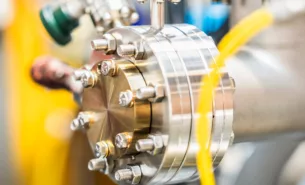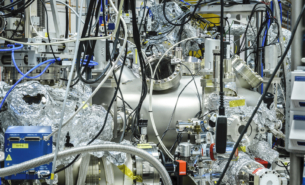Developments in time-resolved catalysis research opens a long-awaited opportunity to revisit catalytic reactions that have been subject to scientific debate. In this recent publication, the newly developed method has been used to settle the mechanism for carbon monoxide transformation to carbon dioxide over a platinum catalyst. The result is an important step towards optimisation of catalysts.
The conversion of carbon monoxide to carbon dioxide with the help of a platinum catalyst is one of the most famous catalytic reactions and one that’s been studied for decades. It happens every day in every car catalytic converter to prevent the emission of highly toxic carbon monoxide. The mechanism for the reaction has, however, been subject to a lot of debate.
It was a big success when, a few decades ago, carbon monoxide oxidation on platinum could be studied with a suite of surface science methods under idealistic conditions: ultrahigh vacuum and low temperatures. The studies suggested that oxygen bound to metallic platinum is the active species in the reaction. However, at the beginning of the 2000s, new tools and experimental methods that could probe the same reaction under realistic conditions, so-called operando, at elevated pressures and temperatures, started to appear. The results suggested a new candidate for the active species, platinum oxide, and the big debate started.
“The main challenge with such a materials system, however, is that although the oxide formation is indeed favourable under operando conditions, its presence does not imply reactivity. With studies done under equilibrium conditions, there is actually no way of telling,” says Andrey Shavorskiy, beamline scientist at the HIPPIE beamline and one of the authors of the study.
Dynamic and time-resolved surface studies have, with faster detectors and brighter synchrotrons, become a hot research topic. Ambient-Pressure X-ray Photoelectron Spectroscopy (AP-XPS) is a method that, through clever engineering, lets researchers do spectroscopic surface measurements under pressure conditions that otherwise would not be compatible with this type of study. It is especially important for catalysts where the function is closely connected to the operating pressure. Combining the two, time resolution with AP-XPS, at the HIPPIE beamline, shows promise for a new era of surface science studies.
“The main difference between all past studies and what we have done at HIPPIE was that we decided to follow the reaction as it happens in real-time. In collaboration with the Synchrotron Radiation Research Division of the Lund University Physics Department, we have developed a suite of time-resolved tools that allow us to look at chemical reactions on surfaces under operando conditions with high enough time resolution to detect the formation of intermediate species. The key parts of the development are the ability to initiate the reaction on the whole sample at the same time with a very fast valve that was developed at MAX IV and the ability to follow the response of the system under such a perturbation with a very high time resolution. We have pushed the AP-XPS experiment to its extreme and can obtain high-quality data with 20–40 µs time resolution. This has never been achieved before with chemical perturbations in an AP-XPS setup,” says Shavorskiy.
The researchers were able to follow the reaction closely and found the actual reaction mechanism, which, with a less exact method, could have been easily missed in overlapping signatures. They foresee that the method will be very attractive to their colleagues in the catalysis and surface science communities in the future.
“When we analyzed the collected spectra, we were able to identify a small region in time when the formation of oxygen bonded to metallic platinum was delayed with respect to the formation of platinum oxide. The reason for this, we reckon, is its very high activity. It never lives long enough on the surface to be detected as it is immediately consumed in the reaction. On the other hand, the platinum oxide is much less reactive, so it can stay on the surface unreacted, and we can detect it.
It is only when the conditions change such that there are no more CO molecules in the reaction mixture, that we can see oxygen bound to metallic platinum in high quantities. This tells us that chemisorbed oxygen on the metallic surface is much more active than the platinum oxide. Moreover, we can only see this within a very short period of time during the reaction cycle. Normally, when studying such reactions, people use much longer time scales, so only a mixture of the two can be observed. However, we have shown within the mixture that the oxide is a lot less active. So, most of the catalysis is done by chemisorbed oxygen,” explains Shavorskiy.
“The ability to follow reactions with such a high time resolution is extremely interesting for scientists studying catalysis. Discriminating the reactive species from the spectating ones is something researchers have been dreaming of for a long time. Moreover, the ability to inject a reactant into the reaction at a very specific and predefined time gives the ability to control the reaction and maybe even drive it in different directions depending on the pulse characteristics. This is what we hope to explore further in 2025.”




